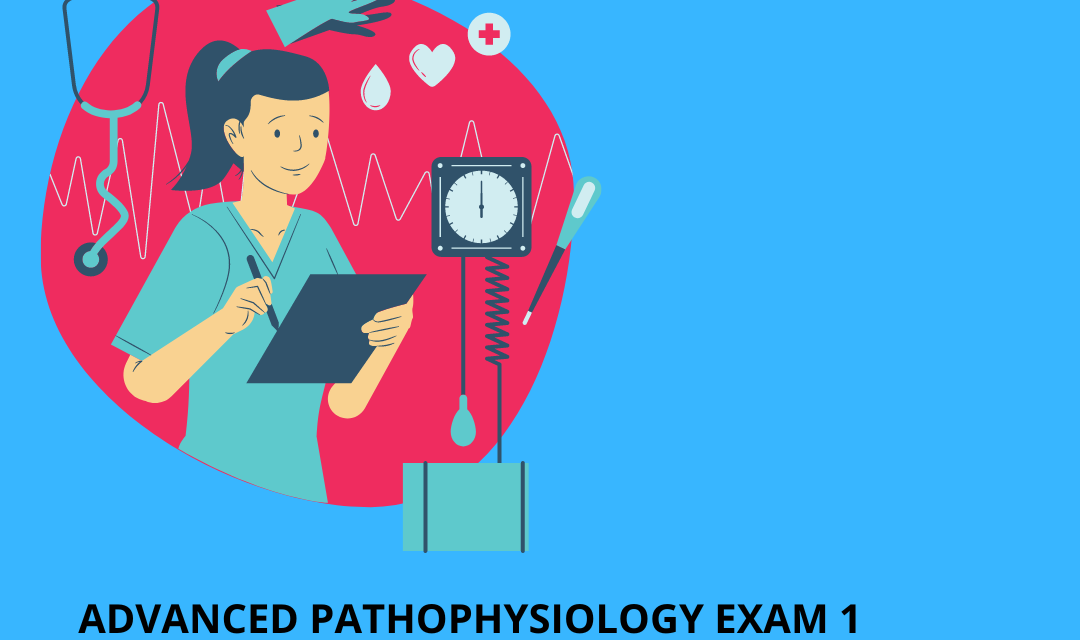-study of human physiologic dysfunction in disease (disruption of homeostasis and feedback loops) 1110 specific diseases have been identified
1. Etiology= causative mechanisms “why”
2. Epidemiology= risk factors and distribution in populations “patterns” incidence and prevalence of disease. Incidence: #of new cases in a given population within a given time. Prevalence: # of cases existing (both old and new) in a given time
3. Pathogenesis= disease mechanisms, sequence of events that occurs from stimulus to disease
4. Clinical manifestations= signs (result of exam/assessment), symptoms and diagnostic criteria
5. Outcomes= cure, remission, chronicity, death

discuss the causes–physiologic and pathologic–of atrophy, hypertrophy, and hyperplasia and give examples
– atrophy: reduction in cell size d/t decrease in work demands or adverse environmental conditions. physiologic: disappear when stressor is removed (thymus gland and child development). pathologic: remain when stressor is removed d/t decreased workload (brain tissue + Alzheimer’s disease)
-hypertrophy: increase in tissue size d/t increase in work demands. physiologic: muscles w/ increased lifting, heart muscles with exercise/pregnancy- can return to norm size. pathologic: after donating a kidney to keep up with workload, dilated cardiomyopathy- never return in size
-hyperplasia: increase in the number of cells in an organ/tissue that is still capable of mitotic division. physiologic: uterus with pregnancy. pathologic: endometriosis
-Compensatory hyperplasia is an adaptive mechanism that enables certain organs to regenerate. For example, removal of part of the liver leads to hyperplasia of the remaining liver cells, callus= thickening of skin d/t stimulus

-atrophy: cell shrink’s d/t decreased workload/stimulus/nutrients
-hypertrophy: adaptive response-cell enlarges d/t increased workload/stimulus/nutrients
-hyperplasia: cell multiplies d/t increased rate of cellular division in response to injury when severe and prolonged

-dysplasia: abnormal changes in size, shape, and organization of mature cells- found in cervix (hpv) and respiratory tract (smoking), strongly associated with neoplastic growths and cancerous cells- is not cancer themselves, can be reversible if stimulus is removed- precursor to cancer
-metaplasia: reversible replacement of mature cell by another- cells in respiratory tract stronger but do not secrete protective mucus (smoking)

4 etiologies/categories based on mechanism of injury:
1. impaired energy production: (most) decreased ATP production d/t (4):
I. hypoxia: most common, lack of O2-aerobic phase cannot continue, anaerobic only=lactic acid
–ischemia, low Hgb/decreased RBC (anemia), carbon monoxide poisoning
II. hypoglycemia: less common, need glucose for ATP, imbalance of insulin–DM
III: inhibition of enzymes: rare, Inhibit electron transport chain by binding more strongly than oxygen
preventing oxygen reduction -cyanide poisoning, antibiotics, pesticides
IV: uncoupling of oxidation and phosphorylation: rare d/t a loss of coupling between electron transport and
ATP production (phosphorylation) -snake venom
2. direct cell membrane injury: free radicals are unstable atoms creating unstable bonds causing damage/toxins
-endothelial damage/atherosclerosis, HTN, DM, hypercoagulability/thrombosis, stroke, cancer, lead
3. genetic alteration: sickle cell anemia
4. metabolic derangement: accumulation of -fat and bilirubin toxic to area of accumulation

Hypoxia is lack of oxygen to a tissue from any cause.-decreased O2 entering mitochondria results in drop of ATP production
-decreased ATP= alters Na/K pump causing increase in intracellular Na and Ca (activates enzymes resulting in membrane/nucleus damage) and extracellular K
-decreased ATP= increase in H20 causes acute cellular swelling and decreased protein synthesis
-decreased ATP= increase in anaerobic glycolysis results in decrease of glycogen, increase in lactate and decreased pH= acidosis= nuclear chromatin clumping
-decreased ATP= alters membrane permeability and membrane potential= necrosis/apoptosis

• Lack of O2 and free radicals: ischemia causes destruction of cell membrane and cell structure
• Intracellular Ca: loss of steady state d/t increase Ca causes intracellular damage by activating enzymes
• Defects in membrane permeability: d/t all forms of cellular injury

-Reactive oxygen species (ROS) have a role in a wide variety of diseases and age-related diseases including cancer, neurologic disease, type 2 diabetes, autoimmune and cardiovascular diseases, infertility, and normal aging. Chronic exposure to ROS and decreased DNA repair can result in persistent DNA mutations.
-Free radicals may be initiated within cells by (1) the absorption of extreme energy sources (e.g., ultraviolet light, x-rays); (2) the occurrence of endogenous reactions, such as redox reactions in which oxygen is reduced to water, as evident in systems involved in electron and oxygen transport (all biologic membranes contain redox systems important for cellular defense, for example, inflammation, iron uptake, growth and proliferation, and signal transduction) or (3) the enzymatic metabolism of exogenous chemicals or drugs
-(1) peroxidation of lipids (destruction);
-(2) alterations of proteins causing fragmentation of polypeptide chains; and
-(3) alterations of DNA, including breakage of single strands.
-ROS can cause: cell growth/proliferation, apoptosis, inflammatory response, necrosis, mitochondria disturbances

-ROS play major roles in the initiation and progression of cardiovascular alterations associated with hypertension, hyperlipidemia, diabetes mellitus, ischemic heart disease, chronic heart failure, and sleep apnea
-Aging, stroke, brain disorders, cancer, DM, eye disorders, RA, ALS, Parkinsons? Huntingtons disease

enzymes: convers superoxide to H2O2 catalase

-pigments, glycogen (d/t lack of lysosomes), Calcium (in areas of cellular death) NA (when Na/K fails)
-(1) a normal cellular substance, such as water, proteins, lipids, and carbohydrate excesses; or
-(2) an abnormal substance, either endogenous, (product of abnormal metabolism), or exogenous (infectious agents or a mineral). These products can accumulate transiently or permanently and can be toxic or harmless. Most accumulations are attributed to four types of mechanisms, all abnormal. Abnormal accumulations of these substances can occur in the cytoplasm (frequently in the lysosomes) or in the nucleus if (1) the normal, endogenous substance is produced in excess or at an increased rate; (2) an abnormal substance, often the result of a mutated gene, accumulates because of defects in protein folding, transport, or abnormal degradation; (3) an endogenous substance (normal or abnormal) is not effectively catabolized, usually because of lack of a vital lysosomal enzyme; or (4) harmful exogenous materials, such as heavy metals, mineral dusts, or microorganisms, accumulate because of inhalation, ingestion, or infection

(d/t increased activity of free radicals)
reoxygenation injury is the tissue damage caused when blood supply returns to tissue after a period of ischemia or hypoxia where free radicals and toxins have been developing resulting in inflammation and oxidative damage via oxidative stress
Reperfusion of ischemic tissues is often associated with microvascular injury d/t increased permeability of capillaries and arterioles that lead to an increase in diffusion and fluid filtration resulting in inflammatory response
—therapeutic hypothermia after ROSC improves and lowers damage

1. increased movement of free fatty acids into the liver
2. conversion of fatty acids to triglycerides instead of phospholipids
3. decreased synthesis and binding of apoproteins (lipid-acceptor proteins)
4. failure to transport lipoproteins out of cell
5. direct damage to the ER by free radicals released by alcohol’s toxic effectsbilirubin (normal pigment of bile from hemoglobin) excess causes jaundice d/t:
1. destruction of RBC
2. diseases affecting the metabolism and excretion of bilirubin in the liver
3. diseases that cause obstruction of the common bile duct (gall stones, tumors)
4. resulting in uncoupling of oxidative phosphorylation and loss of cellular proteins- these 2 affects could cause structural injury to the cell membrane

Calcium is normally removed from the cytosol by ATP dependent calcium pumps. In normal cells, calcium is bound to buffering proteins, such as calbindin or paralbumin, and is contained in the ER and the mitochondria.
If there is abnormal permeability of calcium ion channels, direct damage to membranes, or depletion of ATP (i.e., hypoxic injury), calcium level increases in the cytosol.
If the free calcium cannot be buffered or pumped out of cells, uncontrolled enzyme activation takes place, causing further damage.
Uncontrolled entry of calcium into the cytosol is an important final pathway in many causes of cell death.
Free Ca= activation of enzymes causes: chromatin fragmentation, membrane damage, cytoskeletal damage
Hypercalcemia d/t: hyperparathyroidism, toxic levels of Vit D, hyperthyroidism, Addison’s disease, sarcoidosis, leukemia/cancer, renal failure

karyolysis: Nuclear fading, DNA deteriorates
pyknosis: nucleus condenses and shrinks
karyorrhexis: nuclear fragmentation “rupture”

Necrosis is the sum of cellular changes after local cell death and the process of cellular self-digestion, known as autodigestion or autolysis.Types of necrosis:
o liquefactive necrosis: d/t ischemia or bacterial infection of neurons and glial cells in the brain- forms cysts/puso coagulative necrosis: kidneys, heart, adrenal glands d/t hypoxia from ischemia/chemical injury (ingestion toxins) causing coagulation by denatured proteins that cause albumin to change form (gelatinous to firm-egg white cooked)–MI
o caseous necrosis: TB infection combo coagulative and liquefactive necrosis “clumped cheese”
o fat necrosis: breast, pancreas caused by lipases (enzymes) that break down triglycerides releasing fatty acids that combine with ions creating soaps “chalk white”
o gangrenous necrosis: d/t hypoxic injury and bacterial invasion often arteriosclerosis or blockage of major arteries (lower legs)
• dry gangrene: d/t coagulative necrosis, skin dry and shrinks, turns black
• wet gangrene: neutrophils invade causing liquefactive necrosis- usually internal organs, site cold, swollen black with foul odor, pus
• gas gangrene: d/t clostridium infection “gas bubbles” form in muscle cells- need hyperbaric chamber
o increased heart rate: metabolic processes resulting from fever
o increased leukocytes: d/t infection
o pain: d/t release of bradykinins
o presence of cellular enzymes in extracellular fluid: released enzymes from cells of tissue
• ie lactate: released from RBC, liver, kidney, skeletal muscle
• creatine kinase-CK: released from skeletal muscle, brain, heart
• ALT/AST: released from heart, liver, muscle, kidney, pancreas

necrosis: cell swelling, nucleus: pyknosiskaryorrhexiskaryolysis, disrupted plasma membrane, cellular contents leak enzymes, inflammation present, pathologic d/t irreversible cell injury= d/t external factors
apoptosis: cell shrinkage, nucleus: fragmentation, altered plasma membrane “blebs”, cellular contents intact, no inflammation, often physiologic, can be pathologic with DNA damage= natural

1. generated by signals arising within the cell;
2. triggered by death activators binding to receptors at the cell surface: TNF-α, Lymphotoxin, Fas ligand
3. triggered by dangerous reactive oxygen species.

cancer: Some cancer cells, especially lung and colon cancer cells, secrete elevated levels of a soluble “decoy” molecule that binds to FasL, plugging it up so it cannot bind Fas. Thus, cytotoxic T cells (CTL) cannot kill the cancer cell. Other cancer cells express high levels of FasL, and can kill any cytotoxic T cells
AIDS: All T cells, both infected and uninfected, express Fas. Expression of a HIV gene (called Nef) in a HIV-infected cell causes the cell to express high levels of FasL at its surface while preventing an interaction with its own Fas from causing it to self-destruct. However, when the infected T cell encounters an uninfected one (e.g. in a lymph node), the interaction of FasL with Fas on the uninfected cell kills it by apoptosis
organ transplantation: Graft rejection: The patient’s immune system “sees” an allograft as foreign (antigenic) and mounts an immune response against it.

aging: a normal physiologic process that is universal and inevitable
Cellular changes characteristic of aging include atrophy, decreased function, and loss of cells, possibly by apoptosis. Loss of cellular function from any of these causes initiates the compensatory mechanisms of hypertrophy and hyperplasia of remaining cells, which can lead to metaplasia, dysplasia, and neoplasia. All these changes can alter receptor placement and function, nutrient pathways, secretion of cellular products, and neuroendocrine control mechanisms.




